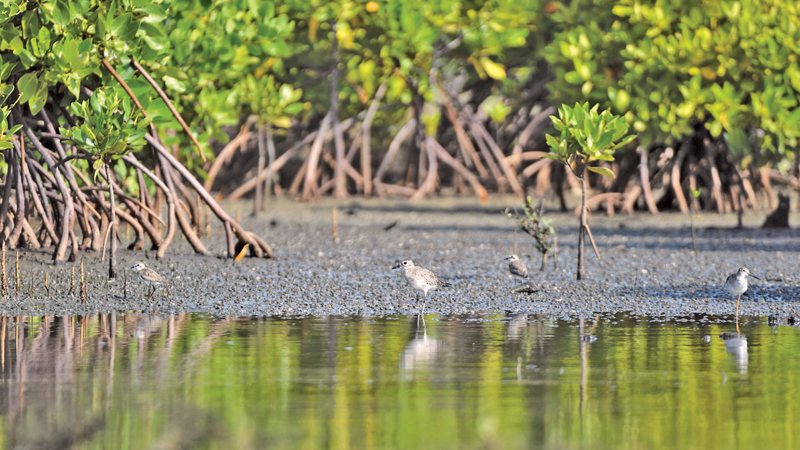Sri Lanka blessed with rich marine biodiversity, stands at a critical juncture in its climate action journey. As global attention increasingly turns to nature-based solutions, blue carbon ecosystems – mangroves, salt marshes, and seagrasses – emerge as powerful allies in the fight against climate change.
These remarkable ecosystems, though covering less than 2% of the ocean, sequester over 50% of the total carbon stored in ocean sediments, offering not only high rates of carbon sequestration but also invaluable co-benefits such as habitat protection, coastal defence, and support for local livelihoods. Sri Lanka is among the fortunate 71 countries that possess all three types of blue carbon ecosystems, placing us in a unique position to leverage their potential. Is it time to turn towards the sea for solutions?
Complexities
The promise of blue carbon schemes, particularly through carbon market-based approaches and Article 6 guidelines of the Paris Agreement, is alluring. They offer a mechanism to mobilise much-needed resources to meet global mitigation goals and our own Nationally Determined Contributions (NDCs). However, as we contemplate diving into blue carbon financing projects, it is imperative to proceed with caution and a clear-eyed understanding of the inherent risks and critical considerations. The path to a sustainable and equitable blue carbon future is fraught with complexities that, if ignored, could undermine the very benefits we seek to achieve.
One of the foremost risks lies in the potential for “carbon colonialism” or “carbon grabbing.” While blue carbon projects promise financial inflows, there is a tangible danger that these initiatives could lead to the dispossession or marginalisation of local communities who have historically relied on and stewarded these ecosystems. The financial allure of carbon credits can create perverse incentives, leading to the enclosure of traditional fishing grounds or the imposition of restrictions on traditional practices without adequate consultation or compensation.
For Sri Lanka, where coastal communities are deeply intertwined with mangrove forests and seagrass beds for their sustenance and cultural heritage, ensuring free, prior, and informed consent (FPIC) from these communities is not merely a procedural step but a fundamental ethical imperative. Without robust safeguards, blue carbon projects could exacerbate existing inequalities and create new conflicts, ultimately jeopardising their long-term success and social license to operate.
Beyond social equity, the permanence and additionality of carbon sequestration in blue carbon projects present significant challenges. Unlike terrestrial forests, blue carbon ecosystems are inherently dynamic and susceptible to a range of natural and anthropogenic disturbances, including extreme weather events, sea-level rise, pollution, and unsustainable development. If a restored mangrove forest is subsequently damaged by a cyclone or encroached upon by illegal construction, the sequestered carbon could be rapidly released back into the atmosphere, negating the climate benefits. Robust monitoring, reporting, and verification (MRV) systems are crucial. Still, even with the best intentions, the long-term permanence of carbon credits derived from these ecosystems remains a scientific and practical hurdle.
Governance
Demonstrating additionality – proving that the carbon sequestration would not have occurred without the project financing – can be complex. We must guard against projects that merely rebrand existing conservation efforts or fund activities that would have happened anyway, thereby undermining the integrity of the carbon market.
Another critical consideration revolves around governance and institutional capacity. Implementing blue carbon projects effectively requires sophisticated legal frameworks, transparent regulatory bodies, and a well-coordinated multi-stakeholder approach. Sri Lanka’s institutional landscape may need significant strengthening to manage the complexities of carbon markets, allocate benefits equitably, and enforce environmental regulations effectively.
Ambiguities in land and resource tenure, overlapping mandates of government agencies, and potential for corruption could derail even the most well-intentioned blue carbon initiatives. A robust and transparent governance structure, free from undue influence, is paramount to ensuring that blue carbon financing genuinely benefits the nation and its environment.
Sri Lanka must carefully assess the financial viability and long-term sustainability of blue carbon projects. While carbon markets offer a revenue stream, the costs associated with project development, implementation, monitoring, and ongoing maintenance can be substantial. Reliance solely on volatile carbon prices can expose projects to financial instability.
Diversifying funding sources, integrating blue carbon initiatives into broader coastal management strategies, and exploring hybrid financing models that blend carbon credits with other revenue streams, such as eco-tourism or sustainable aquaculture, could enhance resilience. The economic benefits must extend beyond project developers and carbon investors to reach local communities directly, fostering a sense of ownership and providing sustainable alternatives to environmentally damaging practices.
IPCC
Finally, the scientific rigour and methodological development of blue carbon projects are still evolving. While the Intergovernmental Panel on Climate Change (IPCC) acknowledges the importance of blue carbon, the methodologies for accurately quantifying carbon sequestration and emissions in these complex ecosystems are still being refined. Sri Lanka must invest in scientific research and capacity building to ensure that its blue carbon projects are underpinned by sound scientific principles and adhere to the highest international standards.
This includes understanding the specific carbon sequestration rates of our local species, the impact of various disturbances, and the most effective restoration techniques tailored to our unique ecological contexts. Without this scientific foundation, our blue carbon efforts risk being perceived as greenwashing rather than genuine climate action.
Sri Lanka’s extraordinary blue carbon ecosystems offer a powerful tool for climate mitigation and adaptation, while also providing a wealth of co-benefits essential for the well-being of our people and nature. However, the pursuit of blue carbon financing must be approached with utmost prudence and foresight. By prioritising social equity, ensuring robust governance and permanence, fostering financial sustainability, and grounding our efforts in sound scientific understanding, Sri Lanka can truly unlock the transformative potential of blue carbon, ensuring a just and sustainable future for our island nation. The blue frontier beckons, but we must navigate it wisely, with the interests of our communities and ecosystems firmly at the helm.
This article was written by researchers at the Centre for a Smart Future (CSF). To read the Blue Carbon Knowledge Primer this article is based on, visit csf-asia.org/knowledge-insights.






